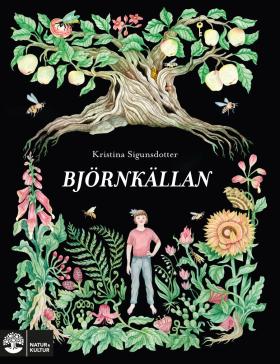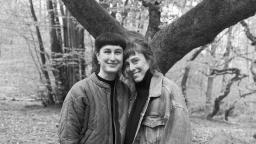
Björnkällan
(The Bear Spring)
by Kristina Sigunsdotter
illustrated by Emma Ekstam
reviewed by Elizabeth Lutz
Hedda has always felt alone. She has no siblings, and moving from place to place as a foster child has made it difficult to keep any permanent friends. Her drug-addicted parents emotionally traumatised her. At her past foster homes she’s been made to feel like an extra worry instead of part of the family. Coming to live with Erna and Eiven, who are old enough to be her grandparents, in a small town at the beginning of the school year is a new start for her. But there are mysteries in the town. The death of a teenager at the Bear Spring near the school decades ago resulted in the area being off limits to students. Yet that hasn’t put students off crawling through the fence. Hedda’s classmate Sire regularly visits the spring, and she shows Hedda how the flowers she planted there come to life. It’s full of carnations, roses, lilies, and forget-me-nots. Even the cut flowers Sire takes from the cemetery revive and bloom again in the soil around the spring, making Hedda and Sire both wonder if the dead girl is somehow haunting the place. Could she be causing the flowers to grow?
Hedda is attracted to Sire because she’s different. She skips school, she doesn’t care what other people think of her, and she’s interested in witchcraft. Sire was bullied by the more popular girls in class until bathing in the spring made her ‘untouchable.’ Then the bullies targeted another classmate, Jon, and finally Hedda herself. None of the kids are willing to turn to the adults in their lives, neither parents nor teachers, for help with their situation. It’s implied that no action would be taken by adults. The teachers do not address the bullying even when they witness it at school. Sire’s single mother works nights and is always sleeping during the day (Sire says resting is her hobby), and Jon’s father is more concerned with making cherry wine than with his son’s problems at school. The suggestion is that bullying is part of the culture and has been for generations. The girl who died so many years ago was Eiven and Erna’s sister Märil. The police treated her death as suicide even though her hands had been tied together before she drowned. When Hedda talks with Eiven about Märil, he tells her that Märil was often bullied, just because she wasn’t like the others. Now the same thing is happening to Hedda. Jon thinks he can stop the bullies by becoming untouchable, but Sire convinces them otherwise. She believes the three of them are meant to release Märil’s spirit from the spring. Only after Märil’s spirit is freed will the bullies leave them alone. The difference in their situations, Sire says, is that Märil was alone, but they have each other.
Things are also not so harmonious at Hedda’s new home. Eiven and Erna were both deeply affected by their sister’s death, and it caused them to drift farther apart rather than closer together. When Hedda puts her hand to the wall, she can sense Märil’s presence. Although Hedda starts to feel like she belongs at her new home, a new experience for her, she also knows that she could be snatched away at any time. There’s an unstated expectation for Hedda to take Märil’s place and mend the relationship between Erna and Eiven.
Sigunsdotter’s strength in the novel is creating an atmosphere—an eeriness—that stays with you after finishing the book: houses cowering beneath the sky, deserted front gardens strewn with faded plastic toys, wasps swarming around rubbish bins and rotting fruit, threatening hornbeams that reach out for Hedda as she cycles past, and the spring itself, whose black water makes it look ‘like a great glistening eye.’ Plants associated with magic and witchcraft are named as well, like rowan, mandrake, nettles, and juniper. Among these is an apple tree once used by people in the town for healing minor ailments, only now the trunk is damaged and all the evil the tree contained is spreading back into the world.The mood of the text is matched by Emma Ekstam’s black and white illustrations. Her depiction of elements from the story is chilling: a toppled chess piece, a broken jar, the backs of children on the swings. Even the sunflowers manage to look sinister instead of cheerful by resembling faceless people. The book is similar to modern classics by Swedish author Maria Gripe such as Agnes Cecilia and Tordyveln flyger i skymningen (‘The Scarab Flies at Dusk’) in the way figures from the past haunt the present. In the same way as Gripe, Sigunsdotter crafts an engaging tale that also employs symbolism for more astute readers to discover.

Björnkällan
Natur & Kultur, 2025, 175 pages.
Rights: Koja Agency
Kristina Sigunsdotter is a writer, artist, and playwright. Her most well-known novel for middle-grade readers, Humlan Hanssons hemligheter (The Secrets of Cricket Karlsson) illustrated by Ester Eriksson, was awarded the August Prize in 2020 and has been translated into over 10 languages. She lives in Malmö.
Emma Ekstam is an artist based in Immeln in southern Sweden. She has also illustrated Döden och alla hans vänner (Death and all his friends) by Kristoffer Leandoer. She is inspired by medieval manuscripts and old churches.
